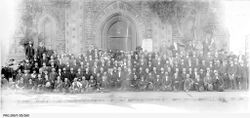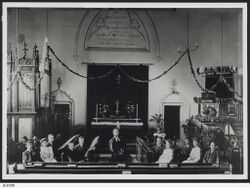Evangelical Lutheran Congregation of Bethlehem (1860-present)
The Bethlehem Congregation in Adelaide was the fourth Lutheran congregation formed in the city of Adelaide and, before the formation of the Lutheran Church of Australia in 1966, was part of the Evangelical Lutheran Synod of Australia/Evangelical Lutheran Church of Australia.
Background
By 1850, there were three Lutheran congregations in the City of Adelaide, each offering a slightly different form of Lutheranism.
The Dresden missionaries Teichelmann and Schürmann were Old Lutherans, Teichelmann from Saxony and Schürmann from Hanover, and had preceded Pastor August Kavel to South Australia in 1838 by about a month. They were initially tasked with setting up a congregation in the city under the direction of Kavel but, upon meeting with Kavel, decided to abandon this aim and focus on their mission work with the Kaurna people. Kavel, and later Daniel Fritzsche, were focussed on their own congregations of Old Lutherans and did not provide services in the city. After the Kaurna mission had failed, and with the schism between Kavel and Fritzsche in 1846, the missionaries began to offer Lutheran services aligned with Fritzsche's Bethany-Lobethal Synod, culminating in 1849 with the dedicating of the first Lutheran church in the city, Trinity on Angas Street. Teichelmann had also been offering services at Klemzig/Windsor to members of the settlement who had not joined
Friedrich Borgelt had arrived with a congregation of Hanoverian Pietists in 1848 and had settled at the largely abandoned Klemzig settlement. With no ordained pastor, they approached Kavel, but the doctrinal differences of the Old Lutherans and the Pietists meant Kavel would not offer them communion. The strong lay focus of Pietism allowed them to call Borgelt, who was not theologically trained, to the be their pastor. Borgelt soon began offering services to Germans in North Adelaide, were large numbers from the northern and western German states had settled, and later at the Bible Christian Church in Young Street in South Adelaide.
The doctrinal differences in Lutheran congregations in the City of Adelaide was exacerbated by the arrival in 1848 of Pastor Andreas Kappler, a Saxon Wendish pastor, who wished to carry on delivering services in line with the Saxon Evangelical Lutheran Church, a form closely aligned with the Prussian Union of Churches. Kappler began preaching Lutheran services at the Scotch Church in Grenfell Street, followed by the Kermode Street Chapel in North Adelaide, servicing those Germans who were more comfortable with the Union form or who did not wish to be involved in the Kavel-Fritzsche disagreement. In 1857 Kappler was invited to preach at the Trinity Angas Street church to a group who were looking for a more 'liberal, progressive' pastor, and the two congregations, 'Old' Trinity and 'New' Trinity, cohabited the site until 1860
Formation
The Bethlehem Church formed in 1860 due to doctrinal differences in both Borgelt's Young Street congregation and the Angas Street Lutheran Congregation (Trinity). Borgelt had died in 1856 and the congregations at Klemzig and Young Street called another layman to be their pastor, Johann Christian Maschmedt, the chief elder of the congregation. The congregations called for a smaller version of their hymnbook to be published, containing the hymns most commonly used, and Maschmedt agreed to take on the task. In 1860 the book was published, but about 40 members, led by Rübenkönig and Scholz, disagreed with Maschmedt's assertions in the foreword that the Earth was not a sphere but a disc with four corners. This group evicted Maschmedt and his followers, who went on to form St Stephen's Congregation, and continued to worship at Young Street.
At the same time

